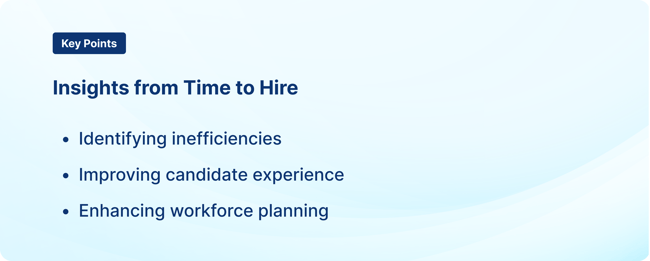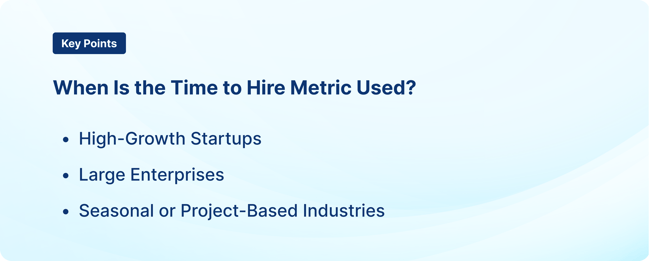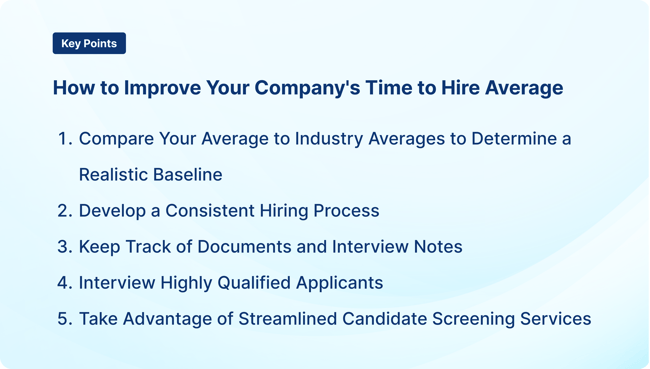

Many companies struggle to find great job candidates to fill open roles. While you may think this...

Time to hire is a core metric in the recruitment process. It measures the timeline from when a candidate applies to when they accept the job offer.
This metric highlights how effective your company's hiring practices are and how swiftly you can secure top talent.
Optimizing time to hire helps you identify bottlenecks and improve your recruitment strategies so you remain competitive.
Below, we provide some time-to-hire insights. Let’s dig in!
Key TakeawaysHere are key takeaways you need to know about the time-to-hire recruitment metric:
|
Time to hire measures the duration it takes for you to complete the hiring process for a specific position.
It starts when a candidate applies and ends when the candidate accepts your job offer. It includes all stages of the recruitment process, including:
Time to fill measures the time from job opening to candidate acceptance. By contrast, time to hire focuses only on the hiring process. It excludes time spent waiting for a candidate's response to the job offer.
You use the average time to hire metric to evaluate recruitment efficiency and identify areas for improvement.
Analyzing this metric allows you to pinpoint bottlenecks in the hiring process, streamline workflows and expedite decision-making.

Time to hire shines a light on three insights:
Overall, the time to hire metric serves as a valuable tool for organizations. It helps you gauge recruitment efficiency, enhance candidate experiences and make data-driven decisions to achieve hiring success.

The time to hire metric is used by companies across different industries to assess and improve their recruitment processes.
Examples of companies that benefit from an optimized time to hire include:
Startups experiencing rapid expansion use the time to hire metric to quickly onboard new talent to support their growth trajectory. High-growth startups often struggle with hiring issues, such as:
Established companies with sizable workforces rely on the time to hire metric to streamline recruitment efforts and minimize hiring costs. They experience issues like:
Seasonal or project-based companies, such as retail, hospitality or construction, use time to hire metrics to manage fluctuations in staffing needs. These companies must overcome challenges such as:

The time to hire metric assesses your recruitment approach and identifies potential issues within the hiring process. You uncover inefficiencies such as lengthy approval processes, communication gaps or sourcing challenges.
Time to hire sheds light on inefficiencies within the hiring process. You can pinpoint specific stages or areas where delays occur. For instance, let’s say the time to hire is delayed due to lengthy approval processes or interview scheduling. You may discover potential bottlenecks in the recruitment workflow.
A shorter time to hire may indicate a highly talented pipeline and successful candidate sourcing efforts. A prolonged time to hire could signify challenges in attracting qualified candidates or mismatches between job requirements and candidate qualifications.
Understanding how your organization's time to hire stacks up against industry standards provides context for identifying areas for improvement. If your timeline is longer than the industry average, you’re almost certainly losing good candidates to your competitors. You may need to streamline processes or invest in tracking software.
To calculate time to hire effectively, it's essential to establish a clear methodology for tracking the duration of the hiring process.
There is one simple formula for calculating time to hire. It involves recording the date when a candidate officially applies for a position and the date when the candidate accepts the job offer.
The difference between these two dates provides the time to hire metric for that specific candidate.
The formula for calculating time to hire can be expressed as follows:
Time to Hire = Date of Candidate Acceptance − Date of Application
You can also determine your company's average time to hire for multiple candidates. Just sum the time to hire values for all candidates and divide by the total number of candidates.
Here are two examples illustrating the calculation of time to hire using the provided formula:
Using the formula:
Using the formula:

Lengthy time-to-hire processes impact your ability to attract and retain top talent. Extended hiring timelines frustrate candidates and increase the risk of losing qualified individuals to competitors.
If you’re facing lengthy time-to-hire challenges, you may struggle to identify root causes and implement effective solutions. Without a streamlined hiring process, you lose valuable candidates and productivity.
To address time-to-hire challenges effectively, you can implement several strategies:
Benchmarking time-to-hire metrics against industry averages provides valuable insights into how your recruitment process compares to competitors. Benchmarks help you set realistic goals and identify areas for improvement.
Establishing a standardized hiring process creates efficiency and transparency. It defines roles and responsibilities and streamlined communication channels. You can reduce delays and enhance the candidate experience to accelerate hiring.
Document management systems can simplify your process and help you make informed decisions. Centralizing your document storage gives everyone access to critical information. You eliminate redundancies and save everyone time.
By focusing resources on the candidates who most closely match job requirements, you secure top talent more efficiently. Providing timely feedback and communication improves the candidate experience and strengthens your brand.
Utilizing streamlined candidate screening services like Cisive can significantly improve your time to hire. Our background checks and verification provide quick and accurate screening so you can focus on evaluating the most qualified candidates. We help companies secure top talent faster by creating a faster, simpler hiring process.
Improving your company's time to hire is crucial for securing top talent and maintaining a competitive advantage.
Strategies such as benchmarking against industry averages, developing a consistent recruiting process, tracking documents and prioritizing qualified applicants reduce hiring time.
Cisive streamlines the candidate screening process for your HR team, allowing you to make smarter hiring decisions. By leveraging our screening solutions, you secure the most qualified candidates in a shorter amount of time.
Discover how Cisive can transform your hiring process. Speak with an expert today!
Author: Cisive Staff
Bio: Contributed by a member of our staff with expertise in background screening for highly regulated industries.
Let's Connect on LinkedIn
Many companies struggle to find great job candidates to fill open roles. While you may think this...

In a world where social media runs rampant, even digital footprints are considered in the hiring...

Bad hires cost businesses. The United States Department of Labor reports that hiring the wrong...